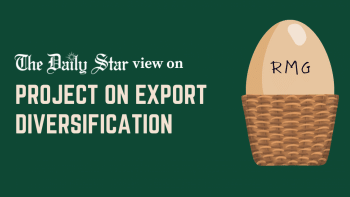We must expand our export capacity

At a time when the economy is going through a turbulent period, it is heartening to know that the apparel sector's dependency on traditional markets, such as the UK, US, Europe and Canada, has reduced to some extent. According to a recent report by this daily, non-traditional markets accounted for 19.3 percent of the total $11.6 billion earned through garment exports during the July-September period of the current fiscal year. Seen from another perspective, garment exports to non-traditional markets grew by 25 percent year-on-year. Among the major non-traditional markets, exports to Japan, Australia and South Korea have increased exponentially.
This is undoubtedly a reassuring sign of progress for the RMG sector considering that, around this time last year, a looming recession in the US and EU led to decreasing orders for garment factory owners. The push for market diversification has served both as a fail-safe and a logical step forward. For a country that is on the path to graduate from the Least Developed Country (LDC) status in 2026 – upon which the current benefits of duty-free market accesses will come to an end – there is no alternative to being competitive and future-oriented. Focusing more on non-traditional markets will ease things for Bangladesh, so it must continue to explore new markets and increase exports.
As the scope of growth in Europe, the biggest market for Bangladeshi exporters, continues to shrink, it is vital to put our eggs in different baskets. We hope to see further growth in the tapped markets of Australia, Japan and South Korea, and at the same time, we encourage RMG business owners to explore the untapped potential of countries such as Saudi Arabia, Qatar, Kuwait and the United Arab Emirates.
Just as the apparel sector is treating export diversification with the importance that it deserves, we hope that other exporting sectors will also come forward and do the same. Doing so, and increasing their export share in the process, is essential for the sake of a sustainable economic growth. In the short term, it can also help increase our foreign exchange reserves, which is critically low at the moment. In the eighth Five-Year Plan (2020-25), the government has rightly attached top priority to diversifying export sectors. The progress in the apparel industry can be a case study for the authorities to expand the export capacity of other sectors.


 For all latest news, follow The Daily Star's Google News channel.
For all latest news, follow The Daily Star's Google News channel. 










Comments